
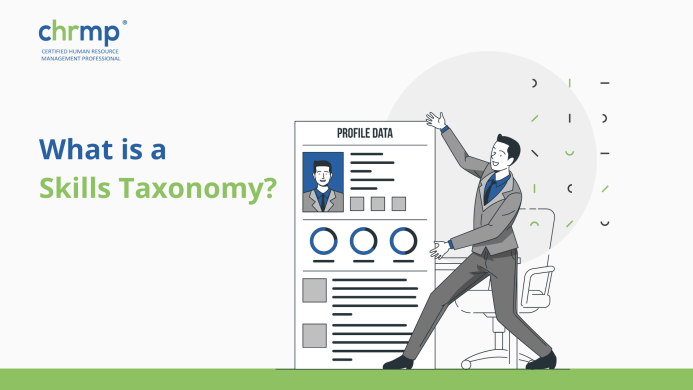
If you’re always looking to improve your professional skills and your team members to their full potential, then your requirement is a crucial tool called skills taxonomy, which does just that.
But what exactly is a skills taxonomy, you ask?
It is a system to categorise and organise various skills, knowledge and abilities of a person or team to perform a task or a job.
Suppose you clearly understand the skills needed for different roles and tasks. In that case, you can quickly assess your strengths and weaknesses while also identifying the areas where you can build upon your strengths and improve upon your weaknesses.
So, without further ado, let’s dive into the world of skills taxonomies and see why they’re a must-have for anyone looking to boost their professional game!
Skills taxonomy is a hierarchical system that defines our various skills, abilities and knowledge to perform any particular task, organise them systematically and improve upon them where necessary.
Essential components of the task and role are broken down into smaller, more manageable ones so that there is no ambiguity and understanding each part becomes easy, simplifying the whole handling of the task.
The skills taxonomy for a project manager, for example, in the attributes category might include qualities such as leadership, good communication, planning, organising and problem-solving, each with its sub-skills. Skills taxonomy might be used as a thumb-rule:
A skills taxonomy is a valuable tool for individuals, teams, and organisations to assess their strengths and weaknesses, set goals for professional growth, and stay ahead of the competitive curve.
Here’s a list of areas where using a skills taxonomy is beneficial and why it’s a must-have for anyone looking to boost their professional game:
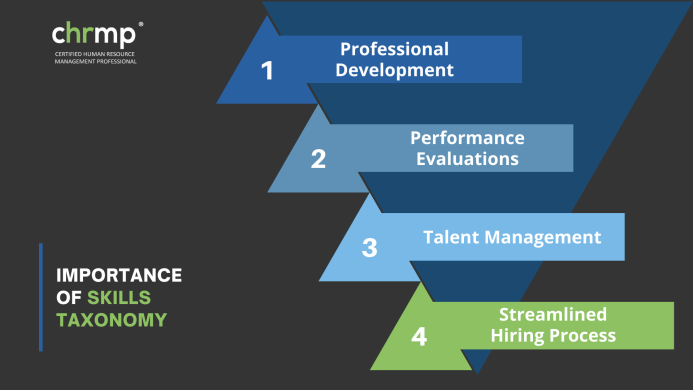
A skills taxonomy helps people understand the skills they need to develop to advance in their careers or move into new roles. It provides a roadmap for growth, allowing individuals to focus their efforts and resources on areas that will impact their career development and achieving their goals.
A skills taxonomy helps managers assess employee skills and identify areas for improvement. It provides a consistent and objective way to evaluate performances while ensuring that evaluations are fair and accurate.
Skills taxonomy can support talent management efforts by clearly understanding the skills and competencies required for each role in an organisation. The taxonomy can be used to guide hiring, training, and professional development initiatives.
A clear understanding of the skills required for a particular role helps organisations ascertain candidate qualifications and ensure that new hires have the necessary skills and qualifications to succeed. A skills taxonomy streamlines the hiring process and ensures that the right candidates are selected for the job.
There are several sources of data that you can use to create your skills taxonomy:

Job descriptions for similar roles within your organisation or industry are among the best data sources for creating a skills taxonomy. This information can provide valuable insights into the skills and competencies required for success in a particular role.
Organisations commonly use competency models to assess the skills and behaviours required for success in various roles. These models can provide a wealth of information on the skills, knowledge, and abilities necessary for a particular role and can be a valuable source of data for your skills taxonomy.
Employee surveys can be an excellent data source for creating a skills taxonomy. By asking employees to identify their strengths and weaknesses and the skills they believe are necessary for success in their role, you can gain valuable insights into the skills critical for success.
Industry reports, and studies can provide valuable information on the skills and competencies that are in demand in your field. This information can be used to inform your skills taxonomy and ensure that it reflects the current job market.
Trade and professional associations can be a valuable resource for information on the skills and competencies required in a particular field. Many of these organisations provide resources such as training materials, job descriptions, and competency models that can be used as a basis for our skills taxonomy.
It’s important to gather data from a variety of sources and to validate the information we collect through research and interviews with experts in the field. A well-researched skills taxonomy will provide a solid foundation for our professional development and the development of our team.
A skills taxonomy and a skills-based approach can provide numerous benefits for HR and managers:
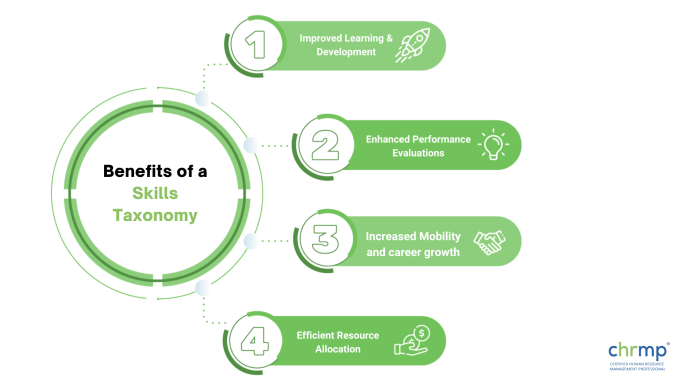
A skills taxonomy gives the numerous HR managers a clear understanding of the skills and competencies needed for success in various roles within an organisation. This information is used to guide learning and development initiatives for the employees, taken by HR managers of respective firms, also ascertaining the training the workforce needs to excel in their roles and advance their careers.
Resource allocation becomes more efficient through a skills-based approach by HR managers. By understanding the skills and competencies required for each role, HR and managers can better match employees with projects, tasks and assignments that align with their strengths and capabilities.
A vertical or lateral skills taxonomy can also support mobility. By clearly understanding the skills and competencies required for various roles, HR and managers can identify opportunities for employees to move into new positions and take on new challenges. This can help organisations foster a culture of growth and development and ensure that employees have the opportunity to advance their careers. This is also a good move to retain talented employees.
A skills-based approach also supports more effective performance evaluations. By clearly understanding the skills and competencies required for each role, managers can assess employee performance in a more meaningful, clinical and objective way. This can help ensure that evaluations are fair and accurate and that employees receive meaningful feedback on their performance.
In conclusion, a skills taxonomy and a skills-based approach provide numerous benefits for HR and managers, including improved learning and development, more efficient resource allocation, enhanced performance evaluation, increased mobility and employee retention.
A skills taxonomy consists of key elements like:
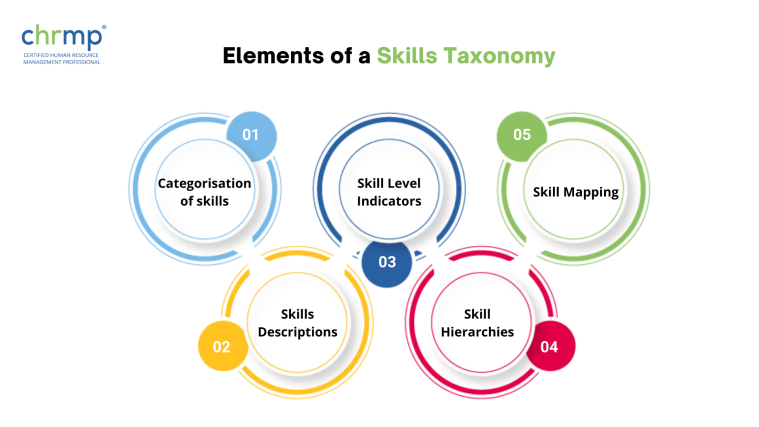
The first element of a skills taxonomy is the categorisation of skills, such as technical skills, interpersonal skills, or leadership skills. This organisation of skills makes it easy to understand and use.
The second element of a skills taxonomy is a detailed description of each skill. This description includes a definition of the skill, a list of related tasks and activities, and examples of how the skill is used in the workplace.
Many skills taxonomies also include a skill level indicator, which provides a way to assess the proficiency of individuals in a particular skill. For example, a skill level indicator may range from basic to intermediate to advanced or use a numerical scale to indicate skill level.
In addition to skill level indicators, some skills taxonomies also include competency indicators. A competency indicator is a statement that defines the level of proficiency, just like the required educational qualification to perform a specific task or job. This clearly explains the skills and behavioural patterns required for success in a particular role.
A skill hierarchy may show that a particular skill is a prerequisite for another skill or that one skill is more advanced than another.
Many skills taxonomies also include a mapping of skills to jobs or roles. This helps organisations to align the skills and competencies required for a particular role with the skills and capabilities of their employees.
There are several ways to take skills taxonomies to the next level.

Skills taxonomies can be integrated with performance management systems to provide a more comprehensive approach to employee development and evaluation. This integration can help organisations to align employee development goals with organisational goals and send employees accurate feedback on their performance.
Utilising artificial intelligence and machine learning (mechanisation) can help organisations to automate the process of skills assessment and to provide accurate and up-to-date information on employee skills, competencies and performance.
By using a skills taxonomy, organisations can create personalised learning paths for employees, providing a customised approach to learning and development that takes into account each employee’s unique strengths and weaknesses.
Encouraging employees to self-assess their skills and competencies can help organisations to match them against such assessments done by HR managers. This might help in bridging the in-between skill gap if the organisation, as well as the employees, can see it clearly.
Skills taxonomy can also be used to enhance recruitment and talent acquisition initiatives. By clearly understanding the skills and competencies required for each role, organisations can more effectively match candidates with job openings and identify skills gaps that may need to be addressed through training or other development initiatives.
Implementing a skills taxonomy can present several challenges and considerations that organisations may need to address. Some of these challenges and considerations include:
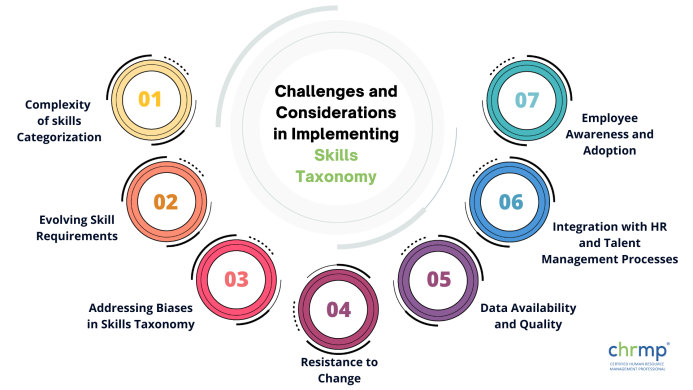
1. Complexity of Skills Categorization:
Categorising skills can be complex, as they can vary in definitions and overlap across different roles or functions. Organisations may need to carefully define and align skill categories to ensure consistency and accuracy in skills taxonomy. Balancing granularity and complexity can be challenging, as too many categories or sub-categories can make the taxonomy unwieldy and difficult to use, while too few categories may not capture the nuances of skills needed in the workforce.
2. Evolving Skill Requirements:
Skills requirements in the workforce can change rapidly due to technological advancements, market shifts, and changing business needs. Organisations need to constantly update and maintain their skills taxonomy to ensure its relevance and accuracy. This can be challenging as it requires ongoing efforts to monitor and capture changes in skills demand and update the taxonomy accordingly to reflect the current skill landscape.
3. Addressing Biases in Skills Taxonomy:
Skills taxonomy can inadvertently introduce biases if not developed and implemented with care. Biases can arise from the selection of skill categories, the definitions of skills, or the sources of data used to create the taxonomy. Organisations need to be mindful of potential biases in skills taxonomy, such as gender or cultural biases, and take steps to mitigate and address them to ensure fairness and equity in talent management practices.
4. Resistance to Change:
Implementing a skills taxonomy may require changes in the organisation’s processes, systems, and mindsets. Some employees or stakeholders may resist these changes due to fear of the unknown, perceived challenges in adopting new practices, or concerns about the impact on their roles or responsibilities. Organisations need to proactively manage change and communicate the benefits and rationale of skills taxonomy implementation to gain buy-in and support from employees and stakeholders.
5.Data Availability and Quality:
Skills taxonomy relies on accurate and up-to-date data on skills possessed by employees. However, organisations may face challenges accessing reliable data on skills, as skills can be subjective, difficult to measure, or not systematically captured in existing HR systems. Ensuring data availability and quality can be a challenge in implementing skills taxonomy, and organisations may need to invest in data collection, validation, and management processes to ensure the accuracy and reliability of skills data.
6. Integration with HR and Talent Management Processes:
Skills taxonomy needs to be integrated into HR and talent management processes, such as talent acquisition, performance management, learning and development, and succession planning, to be effective. However, integrating skills taxonomy into existing processes and systems may require changes in workflows, technology integrations, and employee assessments. Organisations need to carefully plan and execute the integration process to ensure smooth adoption and utilisation of skills taxonomy in HR and talent management practices.
7. Employee Awareness and Adoption:
Employees need to be aware of the skills taxonomy and understand how to use it for their career development. Organisations need to provide employees training, resources, and guidance on navigating and utilising the skills taxonomy to identify skill gaps, set career goals, and plan their professional growth. Employee adoption and engagement with the skills taxonomy can be challenging, and organisations must invest in communication, education, and support to drive employee awareness and adoption.
1. What is the purpose of a skills taxonomy?
The purpose of a skills taxonomy is to provide a comprehensive and structured approach to identifying and categorising skills and competencies required for success in the workplace.
2. How do you create a skills taxonomy?
Creating a skills taxonomy involves several key steps, including identifying the skills and competencies required for success in each role, categorising those skills into broader categories, creating detailed descriptions of each skill, and developing a method for assessing the proficiency of employees in each skill.
3. How do you use a skills taxonomy in the workplace?
A skills taxonomy can be used in a variety of ways in the workplace, including aligning employee development goals with organisational goals, providing employees with regular feedback on their progress, creating personalised learning paths, enhancing recruitment and talent acquisition efforts, and identifying skills gaps that need to be addressed through training or other development initiatives.
In conclusion, a skills taxonomy is a hierarchical organisation of skills that allows for a clearer understanding of the skills required for a specific job or industry.
Having a skills taxonomy helps companies in several ways, including improving job descriptions, creating better training programs, and facilitating better communication between employees and management.
By understanding the skills required for a job, organisations can improve their ability to attract, develop, and retain talent. Investing in a skills taxonomy can lead to a more efficient and effective workforce, increased employee satisfaction and retention and ultimately, a competitive edge in the market.
© 2007-2025 CHRMP| All Rights Reserved | Powered by Ripples Learning & Research Private Limited
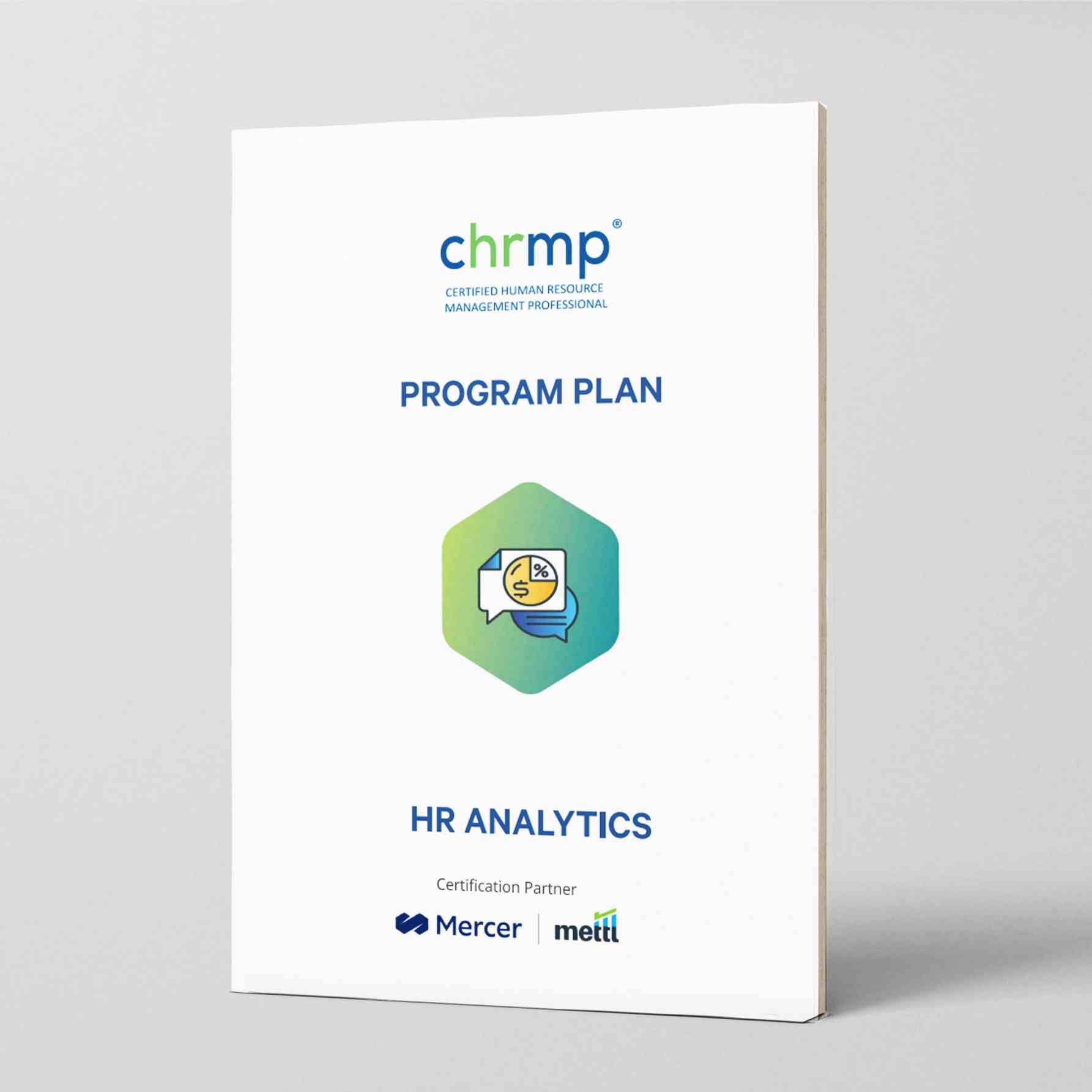
Fill in the below details to get a CHRMP HR Analytics Program Plan.

One Response
Excellent article. I must say it is a comprehensive guide for someone who wants to understand the concept of skills taxonomy. Skills taxonomy plays a perfect role in the recruitment sector by helping hiring managers and recruiters identify the right talent based on their skills.